By Gilles Lecaillon, Etienne Abadie, and Charlotte Soler (founder and CEO, Project Manager, and intern at Ecocean, Ltd.). Ecocean is a French company providing ecological restoration and engineering ideas and services since 2003, including habitat creation for juvenile fish in near-coastal marine ecosystems, and floating islands of vegetation for multiple ecosystem services in fresh water lakes, in Europe, Asia, and elsewhere.
Near-coastal marine ecosystems and their biodiversity are under great pressure from human activities. Ecosystem processes and functionality can be impacted and disrupted by our infrastructures or activities, resulting in losses of ecosystem health and delivery of ecosystem services. Over the past few decades, conservation, revised management, and ecological restoration activities have been designed and implemented with the aim to reduce and compensate for the impacts we have on marine ecosystems. By using technological innovation, ecological engineering, and ecological restoration approaches, we manage to enhance and support different ecological processes, resulting for example in diversification of food chains or complexification of habitats in the targeted aquatic ecosystems. As compared to some terrestrial ecosystems, the science and practice of ecological restoration in marine environments, and of its integration within long term social-economical projects, are still in their infancy. Ecocean, Ltd. and other companies and NGOs are pushing the envelope and the marine portion of the budding restoration sector continues to grow and gain experience.
Ecocean was launched in 2003 by two French marine biologists. Among the approaches developed, the Biohut® was one of the first artificial habitats to be designed anywhere to restore fish nursery functions. This metallic structure, consisting in a central module filled with a natural substrate (oyster shells) and two protective modules, provides food resources and shelter for juvenile fish, wherever essential nursery functions have been impacted by human infrastructures and activities. The Biohut structure provides a simple but efficient technological solution in order to mimic and provide ecological functions of nurseries in as many types of aquatic ecosystems as possible.
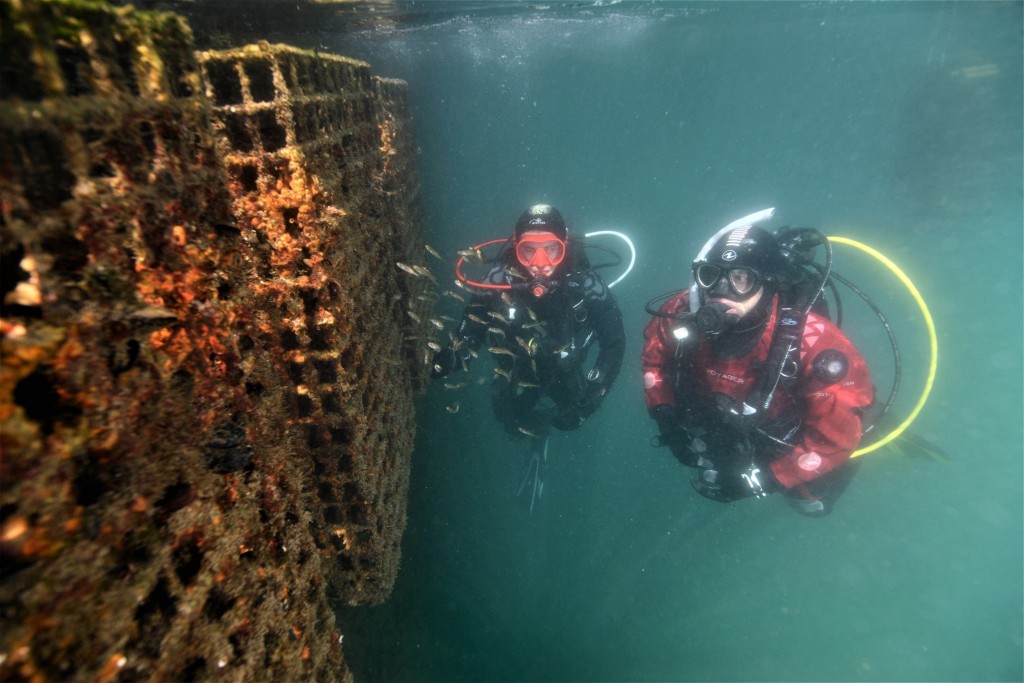
After several successive research projects carried out along the French Mediterranean shoreline, led with the support of scientific partners from the University of Perpignan and Ifremer (the French National Institute for Ocean Science), the ecological value of the Biohut habitat for juvenile fish in port areas was validated (Bouchoucha et al. 2016, Mercader et al. 2017a, 2017b). Various adaptations for different contexts have since then been implemented as ecological restoration tools in order to enhance survival rate and food chain recovery for many species of coastal fish and invertebrates. Today, 40 ports and marinas are equipped with Biohuts to help restore and speed the recovery of nursery functions for juvenile fish, and over 4500 Biohut modules have been installed worldwide in ports, marinas, offshore substations, canals, floating photovoltaic platforms, outfalls at sea, etc. Monitoring is underway at least twice a year in more than 30 different locations.
Ongoing monitoring of the Biohut habitats, performed by scientific divers in order to assess the species colonizing the Biohut and their abundance, have allowed us to observe more than 100 different species of fish and more than 200 different species of invertebrates (crustaceans, mollusks, etc.) using these structures.
As mentioned above, it is critical to closely link ecological restoration and engineering interventions with awareness raising and education for local people and institutions, in order to involve local stakeholders and communities from the beginning of a project. Thus, the impact of restoration actions is not only at the scale of the habitat, but also reaches the social level, with chances of behavior changes that can enhance the gains and recovery made both by the target ecosystem, the local human communities, and human society as a whole.
Additionally, by involving local communities, especially young people, with dedicated activities, Ecocean aims to reach out and bring in these future stakeholders, and tries to influence them to commit themselves to aiding in the protection and restoration of biodiversity and ecosystems. Since 2017, more than 5000 children have been involved in such activities, helping them to reach a good level of implication and understanding of the ecosystems they live near and benefit from.
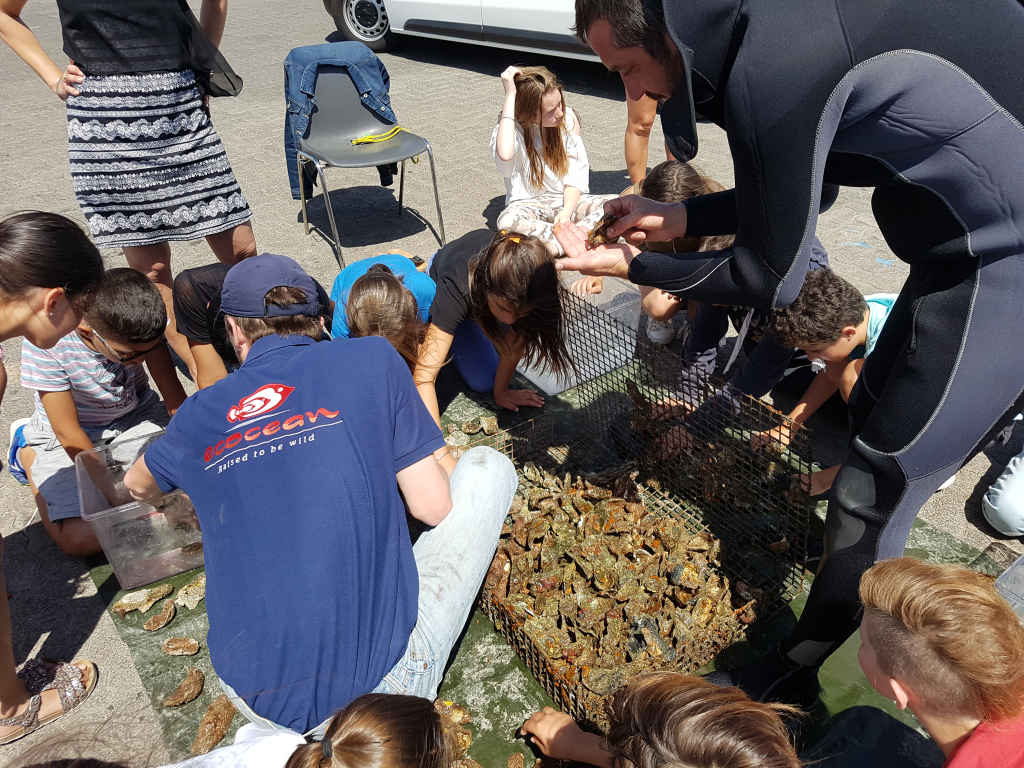
Notes on cultural and natural history
The dusky grouper (Epinephelus marginatus) is an emblematic species throughout the Mediterranean Sea, where it lives near to rocky shorelines and in Posidonia seagrass meadows. Known to be an apex predator, it has a strong ecological role in these ecosystems. Mature individuals can measure up to 1 m in length and have major cultural heritage value, since they are easy and fun to observe. However, because of their docile behavior towards people and the culinary quality of their flesh, groupers have been heavily impacted by fishing and spearfishing for a long time. Groupers are protogynous (female primary sex) hermaphroditic species with the first sexual maturation, as a female, between 2 and 5 years of age, followed by a sex reversal at approximately nine years of age (Faillettaz et al., 2018; Pollard & Francour, 2018). As a result of slow growth, long longevity, and late maturing, as well as a high site fidelity to shallow coastal waters, grouper populations are particularly sensitive to anthropogenic actions such as fishing (Hackradt et al., 2014).
In addition to the fishing pressure, the dusky grouper is subject to a drastic decline in the northwestern Mediterranean due to its unsuccessful recruitment (Bodilis et al., 2003) due to low reproductive success and low survival rate of post-larvae before their coastal settlement.
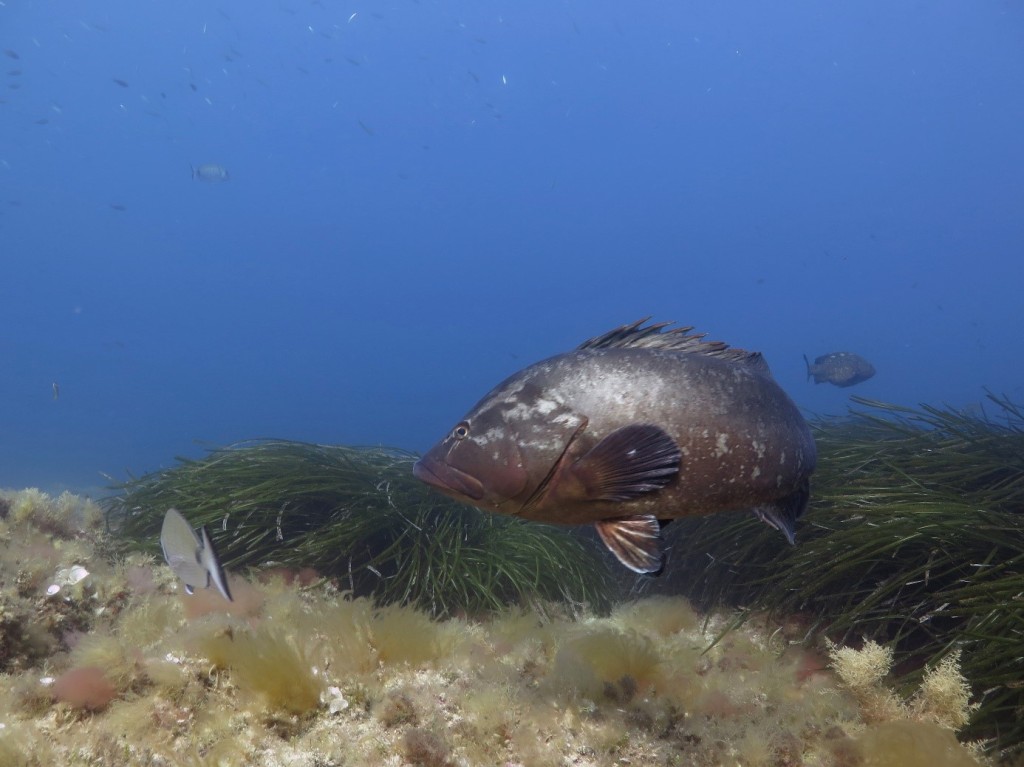
Since 2004, the dusky grouper has been classified as Endangered by the IUCN. It benefits from a fishing moratorium since 1993 that prohibits fishing or spearfishing. Recently, an increase in new, small (under 40 cm) dusky grouper individuals was observed along the French Mediterranean coast, but more help is needed to achieve real recovery.
Sexual activity and reproduction in this species have only been rarely observed by divers along the French Mediterranean coast and near Corsica. However, However, it is important to say that in their natural habitat, small juvenile dusky groupers are difficult to observe as they are cryptic and camouflage themselves very effectively.
Happily, we have recorded several juvenile dusky groupers sheltering in Biohut habitats deployed by Ecocean in Mediterranean ports and marinas. Since the first observations of four dusky groupers between 2013 and 2015 on artificial micro-habitats created by Ecocean (Mercader et al., 2017), more recently 19 new individuals have been sighted across 11 sites along the French Mediterranean coastline between 2016 and 2021. These dusky groupers measured between 4.5 and 15 cm. The increase of the observation of juveniles of this species in artificial habitats can be seen as a good sign for the populations.

Other approaches being tried
In parallel, between 2013 and 2021, across 8 different sites along the Mediterranean French coast, 27 dusky grouper individuals were captured by a system called C.A.R.E (Collect by Artificial Reef Eco-friendly) light traps developed by Ecocean, during four scientific programs conducted by Ecocean, Villefranche’s Oceanographic Laboratory, Paul Ricard Oceanographic Institute, and a European Life + SUBLIMO project. The monitoring of presence/absence, and capture and examination of these juvenile groupers, even if in small numbers, helps to assess the effective reproduction of the species in the northern Mediterranean.
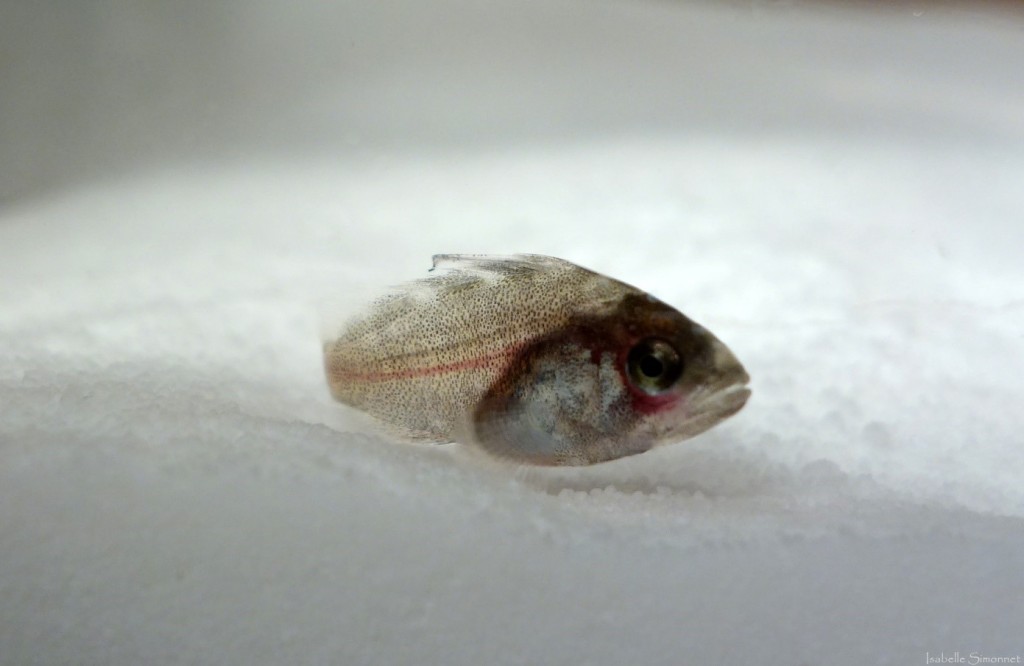
The other ecological restoration process developed by Ecocean consists in capturing fish post larvae with light traps, rearing the juveniles until they reach a safe size (7-10 cm) when they can be reintroduced to natural habitats. This process, called BioRestore, aims to enhance the survival rate of post-larvae juvenile fish, because they are captured at a life stage where their mortality rate is still very high, and this rate is reduced to less than 10% (due to disease and other causes) for the period of several months while they are kept in captivity.
BioRestore is already being implemented and has been refined since 2016 both in Marseille (in the CasCioMar project) and in Toulon (Orrea project) in order to capture and restock fish with enhanced survival rates.
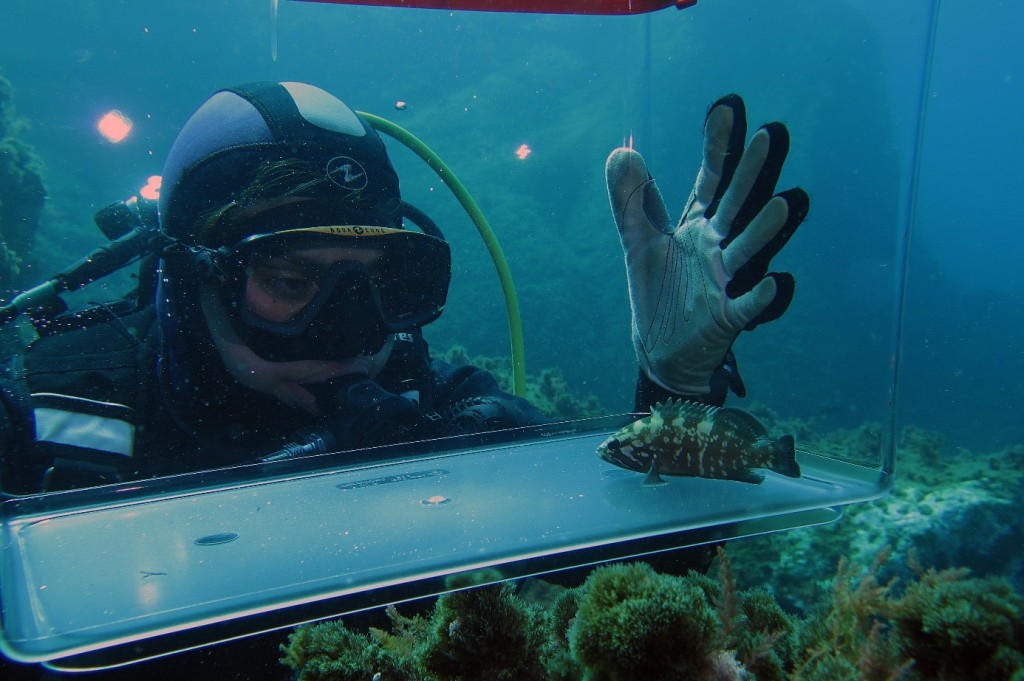
In order not to impact the structure of the communities of fish to which we are putting back rare and keystone species in the wild, all species are released in the same proportions and diversity as captured, so groupers are released 1-2 at a time, as compared to releases of hundreds of individuals from other, smaller species such as seabreams (Diplodus spp.), mullets (Mugilidae), and others.
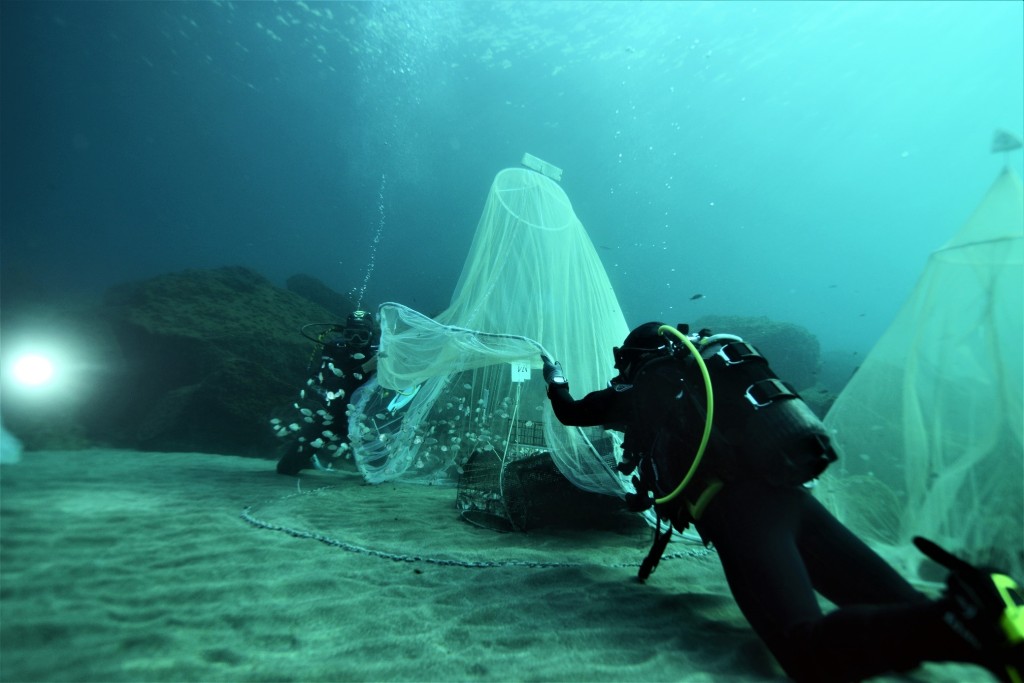
Therefore, despite a low reproductive potential on northwestern Mediterranean coasts, and more particularly in France, post-larval dusky grouper individuals have been observed to benefit from different restoration projects along the French Mediterranean shoreline.
In the natural environment, settled juveniles are difficult to encounter because there is a high larval mortality rate and because newly settled juveniles are difficult to observe as they are quite cryptic.
Similar projects have been implemented by Ecocean divers in other locations, such as in the Marchica Lagoon in Morocco, and there we have also observed juvenile groupers from different species (Epinephelus marginatus and Mycteroperca rubra, among others) settling in the Biohut nursery habitats (Selfati et al. 2018). In addition to the ecological aspect of this implementation, local communities, local university students and professors, and fishers were all involved in the project, in order to have a solid local footprint on both society and environment.
In addition to that, Biohut habitats have been implemented in the French Caribbean islands of Saint Martin and Guadeloupe, and juveniles of other grouper species there have also been observed using Biohut® as their adopted habitat.
The observation of juvenile groupers in various ecosystems shows the potential of the tools described here for fish species with strong ecological value and cultural heritage in many parts of the world. They can provides juvenile with suitable growing conditions where nursery habitat functions have been impacted or the habitat completely destroyed. Additionally, they can be very effective and compelling for communication and outreach to local communities regarding the importance of conservation, management, and where needed, reintroduction and reinforcement of natural populations of emblematic, apex predator fish such as the dusky grouper and many others. Ecocean and all its staff are committed to pushing this important work further.
References:
Bodilis, P., Ganteaume, A., & Francour, P. 2003. Presence of 1 year-old dusky groupers along the French Mediterranean coast. J. Fish Biology 62:242–246.
Bouchoucha, M. et al. 2016. Potential use of marinas as nursery grounds by rocky fishes: insights from four Diplodus species in the Mediterranean. Marine Ecology Progress Series 547:193-209.
Faillettaz, R., et al. 2018. First records of dusky grouper Epinephelus marginatus settlement-stage larvae in the Ligurian Sea. Journal of Oceanography, Research and Data 10:1–6.
Hackradt, C. W., et al. 2014. Response of rocky reef top predators (Serranidae: Epinephelinae) in and around marine protected areas in the Western Mediterranean Sea. PLoS ONE 9(6).
Mercader, M., et al. 2017a. Small artificial habitats to enhance the nursery function for juvenile fish in a large commercial port of the Mediterranean. Ecological Engineering 105: 78-86.
Mercader, M., et al. 2017b. Observation of juvenile dusky groupers (Epinephelus marginatus) in artificial habitats of North-Western Mediterranean harbors. Marine Biodiversity 47:371–372.
Pollard, D.A & Francour, P. 2018. Mycteroperca rubra. The IUCN Red List of Threatened Species 2018: e.T14054A42691814.
Selfati M., et al. 2018. Promoting restoration of fish communities using artificial habitats in coastal marinas. Biological Conservation 219:89-9.